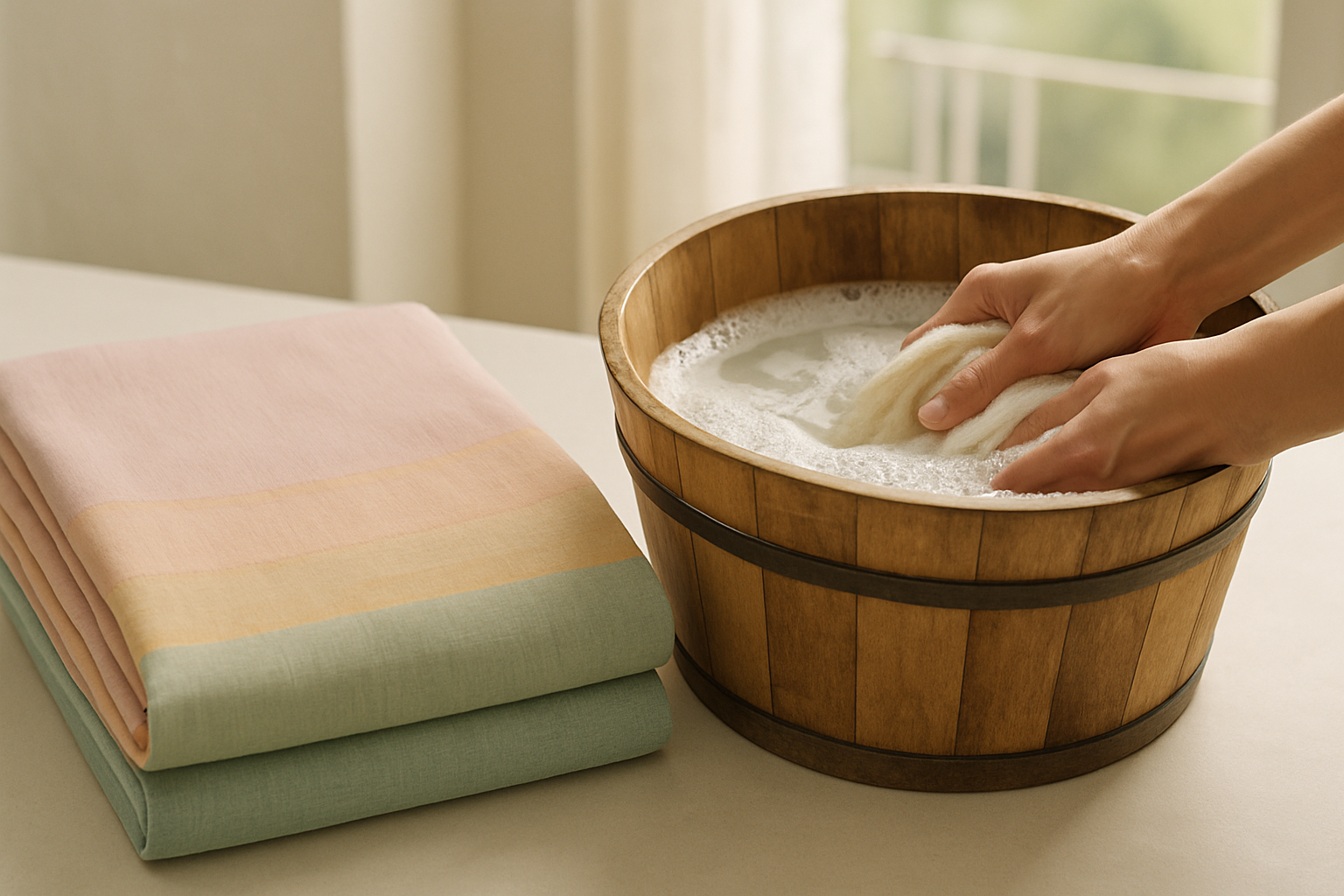How to Wash and Maintain Cotton Sarees for Daily Use

Cotton sarees are very popular among Indian women, especially for day-to-day wear. They are so soft, breathable, and comfortable to wear daily.
The daily wear cotton sarees are comfortable, elegant, and make you feel good at the same time. But, if you want to continue enjoying everyday wear comfort, you have to take care of your sarees.
We know how much you love your cotton sarees. That's why we created a simple guide for you to care for and wash, dry, iron, and store your sarees to keep them fresh and beautiful for many years. So, let's learn how to take care of them!
1. Why Cotton Sarees Deserve Special Care
Cotton sarees consist of a natural fiber material. They allow their shape, color, and softness to be lost, understandably so, if not used correctly.
Consider that most people wear sarees several times per week. All this washing and drying will age the saree if done improperly.
Cotton can require more care than synthetic fabrics. You must understand that cotton sarees worn daily are in contact with sweat, dust, and sunlight. They can fade more quickly or shrink. So, treat your saree as it needs to be treated.
Proper care will keep your raw cotton yarn colors bright, fabric smooth, and intact. When heeded, the proper care of each saree means having an extended life and remaining new for however many days you wear it.
2. The Right Way to Wash Your Cotton Saree
The first and last step for correctly washing your cotton sarees is understanding that it is important to wash your cotton saree correctly, whether it is a simple basic cotton saree or with special prints like bandhani; the method is simple yet careful.
First Wash: New cotton sarees need to be soaked in cold water with a little salt for 10-15 minutes before first washing. This is to set colour and reduce bleeding in the subsequent washes.
Washing by Hand: Hand washing is always safe. First, wash the saree with mild detergent or liquid soap. Do not use harsh cleaners or bleach as they will ruin the fabric. Just swirl your saree in the soapy water - do not rub or scrub, and rinse in cold water.
Machine Wash: If you are washing the saree in a machine, it is important to use a laundry bag or pillowcase. Set your washing machine to a delicate cycle and cold water, and spin at low speed.
How often: You can wash a cotton saree after every day of wearing (daily-cotton sarees) as long as you wash it gently.
Tip: So that they do not get "worn," make sure to not leave them soaking in water, or rub too hard, especially if the fabric is printed or dyed.
3. How to Handle and Dry Your Cotton Saree
After washing, the next step is drying. How you dry your cotton sarees for daily wear is very important to preserve their shape and handle.
Drip Dry Naturally: Always let your cotton saree drip dry naturally. Do not wring it too aggressively, as this will damage the fabric and create wrinkles in it.
Dry in the Shade: Sunlight will fade your saree. When drying, place it in the shade, which is especially important if the saree is dyed or has rich prints. You can use a shaded balcony or an indoor clothesline to hang it up.
Hang Dry: You can hang your saree the long way on a plastic hanger. This reduces creasing. If you fold it to allow it to dry flat, you could possibly get very hard fold marks, which are difficult to iron later on.
Don't use a dryer: Electric dryers create shrinkage in cotton sarees, and the fabric becomes rough.
4. Ironing Tips for a Crisp Cotton Saree
Ironing gives your cotton saree a fresh and crisp appearance, but cotton is highly heat-sensitive, so it requires special consideration.
Use Medium Heat: Always set your iron to a medium or cotton heat setting. If you select high heat on your iron, it can either harm the fabric or leave unsightly shiny patches.
Iron When Slightly Damp: You may find it easiest to iron your saree while it is still slightly damp. This way, you can easily smooth out wrinkles, and it provides a smoother finish.
Use a Press Cloth: If you're concerned about scorching the saree (or fabric burns), you can further protect it by placing a thin cotton cloth on top of the saree while ironing. This will reduce contact and eliminate any potential burns or marks that could occur.
Ironing Inside Out: If the saree has prints or embroidery, and you want to iron, do it on the reverse side to prevent the dye from fading.
Using Steam Iron: When ironing daily wear cotton sarees, a steam iron will help remove the deep wrinkles, without making the fabric stiff.
Regular and gentle ironing of your cotton saree will not only look good but will keep the fabric soft and ready to wear each and everyday out of your closet.
5. Storing Your Cotton Saree to Keep It Fresh
How you store your saree can have a significant impact on how long your saree lasts. Even the best cotton fabric can fade, wrinkle, or absorb a smell if not stored well.
Always Fold Neatly: After ironing, you should fold your saree nicely along the pleats. This will ensure the saree's shape is not compromised and will not have deep wrinkles.
Use cotton or muslin covers: You should store your daily wear cotton sarees in breathable cloth covers, not plastic bags. Plastic will hold moisture and will create a musty smell or yellowing of fabric.
Change folds regularly: You should remove the saree every 1–2 months, fold it differently, and air it for a few hours. This will help eliminate damage from fold marks and allow the fabric to breathe.
Keep in a cool, dry place: You should avoid putting them in damp places like the bathroom or under a sink. Mildew can form with moisture.
Use natural freshener: You can use dried neem leaves or use little pouches of lavender to keep your saree fresh and insect-free.
6. Dealing with Stains and Damage on Cotton Sarees
Prompt Treatment: The sooner you treat any blemish, the better. Use a damp cloth and gently dab the blemished area. If you aggressively rub the impacted fabric, you will just make the blemish bigger.
Mild Solutions: For minor blemishes, just use cold water with some mild detergent. For food and some oil blemishes, you can use baking soda mixed with water. Leave the mixture for a few minutes and wash gently.
No Harsh Chemicals: Avoid bleach and other harsh stain removers. They will ruin the color of the fabric and loosen the fabric itself.
Tears and Holes: Minor tears can be repaired with hand stitching. If the damage is near the border or border of the pallu, take your saree to a tailor so the repair is neat and not obvious.
7. The Importance of Regular Maintenance for Longevity
Taking care of your daily wear cotton sarees goes beyond just washing and storing. It is about developing a care habit that aids a saree in lasting longer.
While cotton is certainly stronger than it will diminish over time if neglected; washing, handling, and ironing can protect its quality when done routinely. Yes. You don’t have to extend yourself beyond that.
If you wear a saree twice a week, when you wash it, dry it, and then fold it to put it away. If you have a few daily wear cotton sarees and rotate them, you will reduce the chances of fading and tearing.
Final Thoughts
Cotton sarees for daily use offer a blend of comfort, style, and tradition. In order to continue reaping the enjoyment of wearing them daily, you must take care of them. It is important to wash carefully, avoid direct sunlight when drying, to iron with care, and to store properly, can have a great influence on longevity.
Find your next cotton saree at KCPC Saree, and use these simple tips to continue wearing it fresh, soft, and graceful, day after day.
-
Posted in
Care Guide





